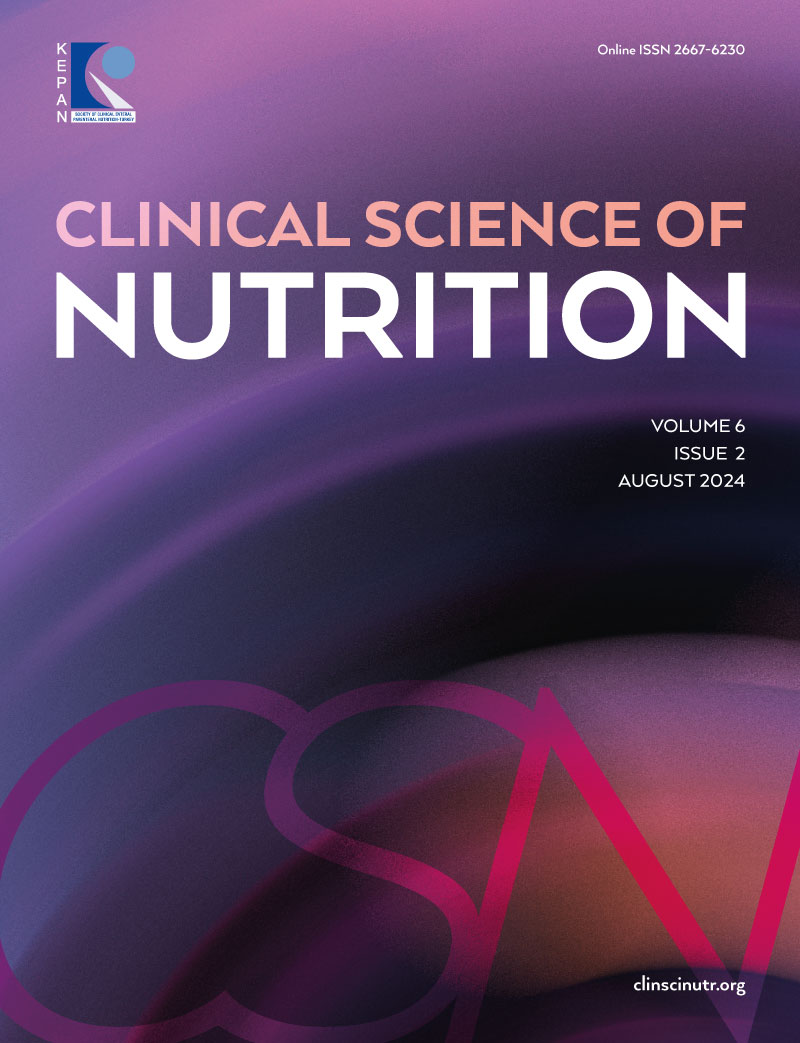Abstract
Objective: This study aimed to determine food waste rates in intensive care patients.
Methods: In this cross-sectional study, 45 patients in the intensive care unit were assessed for malnutrition risk using NRS 2002. Food waste rates were calculated by weighing the weight of the food served and left on the plate. Energy density of foods was calculated. The patients’ energy and nutrient intakes were calculated. Evaluated according to the recommendations of the Türkiye Dietary Guidelines.
Results: 55.55% of the patients had severe malnutrition. Patients cannot consume 38.17% of the food served. The highest waste rate is in vegetables and salads (75.35%). The energy density of patients’ food consumption is low. The patients’ energy and protein intake was 828.56 kcal/day and 32.13 g/day. Energy and nutrient intake are below recommended, except for sodium and vitamin B12. A moderate positive correlation was found between hand grip strength and energy (r=413, p=0.001) and protein (r=453, p=0.001) intake.
Conclusion: Patients cannot consume approximately 40% of the food. Improved protein and energy intake increased muscle strength and performance. Since a decrease in food intake will cause malnutrition to worsen, there is a need to develop strategies to increase energy and protein intake in these patients.
Keywords: intensive care, malnutrition, plate waste, food intake
References
- Lew CCH, Yandell R, Fraser RJL, Chua AP, Chong MFF, Miller M. Association between malnutrition and clinical outcomes in the ıntensive care unit: A systematic review. JPEN J Parenter Enteral Nutr. 2017;41:744-758. https://doi.org/10.1177/0148607115625638
- Saka B, Altınkaynak M, Erten SN, et al. Malnutrition Prevalence Measurement and Nutritional Interventions in Internal Medical Departments of Turkish Hospitals: Results of the LPZ Study. Clin Sci Nutr. 2021;2(3):97-102. https://doi.org/10.5152/ClinSciNutr.2020.21-2-3
- van Zanten ARH, De Waele E, Wischmeyer PE. Nutrition therapy and critical illness: practical guidance for the ICU, post-ICU, and long-term convalescence phases. Crit Care. 2019;23:368. https://doi.org/10.1186/s13054-019-2657-5
- Kontogianni MD, Poulia KA, Bersimis F, et al. Exploring factors influencing dietary intake during hospitalization: Results from analyzing nutritionDay's database (2006-2013). Clin Nutr ESPEN. 2020;38:263-270. https://doi.org/10.1016/j.clnesp.2020.04.001
- Schiavone S, Pelullo CP, Attena F. Patient Evaluation of food waste in three hospitals in Southern Italy. Int J Environ Res Public Health. 2019;16:4330. https://doi.org/10.3390/ijerph16224330
- Simzari K, Vahabzadeh D, Nouri Saeidlou S, Khoshbin S, Bektas Y. Food intake, plate waste and its association with malnutrition in hospitalized patients. Nutr Hosp. 2017;34:1376-1381. https://doi.org/10.20960/nh.1102
- Wunderle C, Gomes F, Schuetz P, et al. ESPEN guideline on nutritional support for polymorbid medical inpatients. Clin Nutr. 2023;42:1545-1568. https://doi.org/10.1016/j.clnu.2023.06.023
- Bahat G, Akmansu M, Güngör L, et al. Beslenme destek tedavisinde oral nütrisyonel destek ürünleri kullanımı: KEPAN rehberi. Clin Sci Nutr. 2022;4(Supplement 1):S1-S35. https://doi.org/10.5152/ClinSciNutr.2022.120122
- Thibault R, Abbasoglu O, Ioannou E, et al. ESPEN guideline on hospital nutrition. Clin Nutr. 2021;40:5684-5709. https://doi.org/10.1016/j.clnu.2021.09.039
- Pertzov B, Bar-Yoseph H, Menndel Y, et al. The effect of indirect calorimetry guided isocaloric nutrition on mortality in critically ill patients-a systematic review and meta-analysis. Eur J Clin Nutr. 2022;76:5-15. https://doi.org/10.1038/s41430-021-00919-0
- Kondrup J, Allison SP, Elia M, Vellas B, Plauth M, Educational and Clinical Practice Committee, European Society of Parenteral and Enteral Nutrition (ESPEN). ESPEN guidelines for nutrition screening 2002. Clin Nutr. 2003;22:415-421. https://doi.org/10.1016/s0261-5614(03)00098-0
- T.C. Sağlık Bakanlığı. Türkiye Beslenme Rehberi (TÜBER). Sağlık Bakanlığı Yayın No: 1031. Ankara; 2022.
- Rolls BJ. Dietary energy density: Applying behavioural science to weight management. Nutr Bull. 2017;42:246-253. https://doi.org/10.1111/nbu.12280
- Mohialdeen Gubari MI, Hosseinzadeh-Attar MJ, Hosseini M, et al. Nutritional status in intensive care unit: A meta-analysis and systematic review. Galen Med J. 2020;9:e1678. https://doi.org/10.31661/gmj.v9i0.1678
- Marinho R, Pessoa A, Lopes M, et al. High prevalence of malnutrition in Internal Medicine wards - a multicentre ANUMEDI study. Eur J Intern Med. 2020;76:82-88. https://doi.org/10.1016/j.ejim.2020.02.031
- Gomes A, Saraiva C, Esteves A, Gonçalves C. Evaluation of hospital food waste-a case study in Portugal. Sustainability. 2020;12(15):6157. https://doi.org/10.3390/su12156157
- Sauer AC, Goates S, Malone A, et al. Prevalence of malnutrition risk and the impact of nutrition risk on hospital outcomes: Results from nutritionDay in the U.S. JPEN J Parenter Enteral Nutr. 2019;43:918-926. https://doi.org/10.1002/jpen.1499
- Correia MITD, Sulo S, Brunton C, et al. Prevalence of malnutrition risk and its association with mortality: nutritionDay Latin America survey results. Clin Nutr. 2021;40:5114-5121. https://doi.org/10.1016/j.clnu.2021.07.023
- Singer P, Blaser AR, Berger MM, et al. ESPEN guideline on clinical nutrition in the intensive care unit. Clin Nutr. 2019;38:48-79. https://doi.org/10.1016/j.clnu.2018.08.037
- Bechthold A. Food energy density and body weight. Ernahrungs Umschau. 2014;6(1):2-11.
- Wang CY, Fu PK, Huang CT, Chen CH, Lee BJ, Huang YC. Targeted energy intake is the important determinant of clinical outcomes in medical critically ill patients with high nutrition risk. Nutrients. 2018;10:1731. https://doi.org/10.3390/nu10111731
- Alberda C, Gramlich L, Jones N, et al. The relationship between nutritional intake and clinical outcomes in critically ill patients: results of an international multicenter observational study. Intensive Care Med. 2009;35:1728-1737. https://doi.org/10.1007/s00134-009-1567-4
- Nicolo M, Heyland DK, Chittams J, Sammarco T, Compher C. Clinical outcomes related to protein delivery in a critically ill population: A multicenter, multinational observation study. JPEN J Parenter Enteral Nutr. 2016;40:45-51. https://doi.org/10.1177/0148607115583675
- Dresen E, Pimiento JM, Patel JJ, Heyland DK, Rice TW, Stoppe C. Overview of oxidative stress and the role of micronutrients in critical illness. JPEN J Parenter Enteral Nutr. 2023;47(Suppl 1):S38-S49. https://doi.org/10.1002/jpen.2421
Copyright and license
Copyright © 2024 The author(s). This is an open-access article under the terms of the Creative Commons Attribution License (CC BY) which permits unrestricted use, distribution, and reproduction in any medium or format, provided the original work is properly cited.










